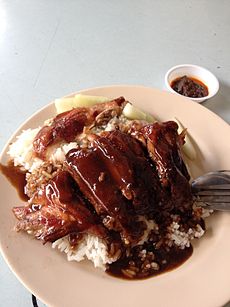Duck rice
This article has multiple issues. Please help improve it or discuss these issues on the talk page. (Learn how and when to remove these messages)
|
 Roast duck rice served at a Kopi tiam in Singapore | |
| Place of origin | Southeast Asia |
|---|---|
| Region or state | Greater China, Mainland Southeast Asia, Maritime Southeast Asia |
| Associated cuisine | Singapore, Malaysia, Indonesia, Brunei, and Thailand |
| Main ingredients | Duck, maltose or honey, rice vinegar, rice |
Duck rice (simplified Chinese: 鸭饭; traditional Chinese: 鴨飯; pinyin: yā fàn) is a Southeast Asian meat dish usually consumed by the Chinese diaspora in Maritime Southeast Asia, made of either braised or roasted duck and plain white rice. The braised duck is usually cooked with yam and shrimps; it can be served simply with plain white rice and a thick dark sauce; side dishes of braised hard-boiled eggs, preserved salted vegetables, or hard beancurd may be added. In addition, Teochew boneless duck rice is a similar, but a more refined dish; due to the slightly tougher texture of duck, the duck is artfully deboned and sliced thinly for the convenience and ease of the diner, allowing the sauces to seep into the meat, making it a more pleasant experience on the whole; Hainanese chicken rice and other similar dishes have followed this style due to the popularity.
This dish can commonly be found in food centers all around Singapore.
In Thailand this dish is called Khao na ped (ข้าวหน้าเป็ด; lit: "rice topped with duck"), and is sold by street vendors or in restaurants inside shopping malls. A Bangkok neighborhood that specialises in its duck rice is Bangrak on Charoen Krung road. [1] In addition, it has also been adapted to other dishes by mixing roasted red pork and Chinese sausage with a special gravy, a dish called Khao che po (ข้าวเฉโป) or Khao sia po (ข้าวเสียโป), meaning "gamble away rice". It is considered traditional Teochew cuisine.[2]
See also
- Siu mei are Cantonese roast meats, often sold together with plain rice
- List of duck dishes
- List of rice dishes
References
- ^ ""ประจักษ์" อร่อยกับเมนูเป็ด สูตรเด็ดนับร้อยปี". Manager Daily (in Thai). 2012-07-15.
- ^ Rayonghip (2014-09-09). ""ข้าวเฉโป"". facebook (in Thai).
